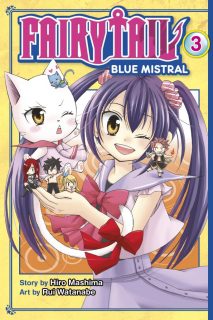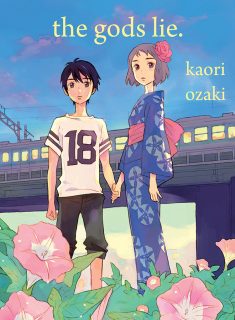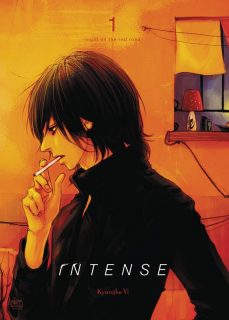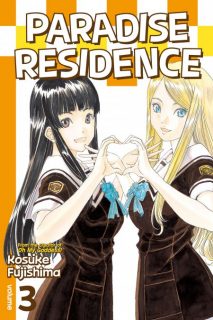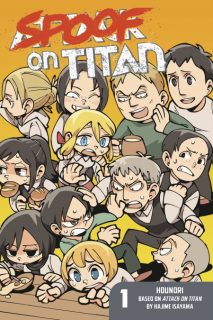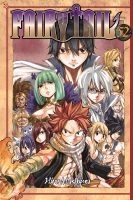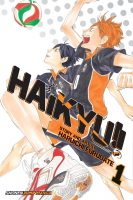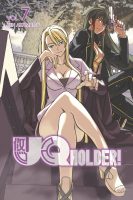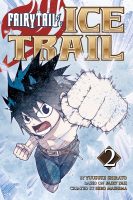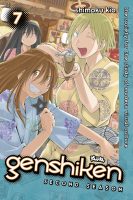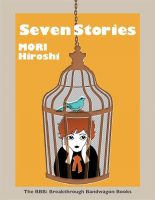My News and Reviews
In addition to the usual My Week in Manga, two other features were posted at Experiments in Manga last week. First up was the most recent monthly giveaway. The winner won’t be announced until Wednesday, so there’s still a little time left to enter for a chance to win the first volume of Oresama Teacher by Izumi Tsubaki. (I finally got around to reading Oresama Teacher because I love Tusbaki’s other manga series Monthly Girls’ Nozaki-kun so much. I am delighted to report that Oresama Teacher is great, too.) I also posted my review of the first omnibus of Sweet Blue Flowers by Takako Shimura last week. The manga was one of the debuts that I was most excited for this year and I was not at all disappointed. Like Shimura’s earlier series Wandering Son (which is an extremely important manga to me personally), Sweet Blue Flowers is a beautiful work. I’m so glad that it’s finally getting the print release it deserves and look forward to reading the rest of the series. (Now if only the rest of Wandering Son could be published, too! My fantasy is that Sweet Blue Flowers will be so successful that more of Shimura’s work will be translated.) Once again, I wasn’t actually online much last week and I worked on Sunday so I’m sure there’s plenty of news that I’ve missed. However, I did catch that Thomas Baudinette posted a translation of “Painting the essence of gay erotic art”–an interview with Gengoroh Tagame from a 2014 issue of the art magazine Bijutsu Techo.
Quick Takes
 Fairy Tail: Rhodonite by Kyouta Shibano. At first I was a little confused by the “2” emblazoned upon the cover of Rhodonite since it’s not in fact the second volume of Rhodonite. Instead, it’s the second volume in Shibano’s Fairy Tail Gaiden manga, one of a multitude of series spinning off from Hiro Mashima’s Fairy Tail that have recently been translated into English. Despite retaining the volume designations, the Fairy Tail Gaiden manga are being released as independent works by Kodansha Comics. Shibano’s three spinoff volumes, while relying very heavily on the original series, largely stand alone from one another. Rhodonite collects two side stories featuring Gajeel Redfox, one of the Dragon Slayers associated with the Fairy Tail Guild. Since I’m not especially well-versed in the Fairy Tail franchise, I’m not exactly sure where the first story, from which the volume gains its name, fits in. However, it does reveal more of Gajeel’s past and backstory as the guild is investigating the magic drug trade. The second story takes place while Gajeel is a member of the Magic Council during Fairy Tail’s disbandment. In this story he temporarily teams up with Cobra to rescue a group of children who were kidnapped to be sold as slaves. Already intended for those already familiar with Fairy Tail, Rhodonite will even more specifically appeal to those who are fans of Gajeel.
Fairy Tail: Rhodonite by Kyouta Shibano. At first I was a little confused by the “2” emblazoned upon the cover of Rhodonite since it’s not in fact the second volume of Rhodonite. Instead, it’s the second volume in Shibano’s Fairy Tail Gaiden manga, one of a multitude of series spinning off from Hiro Mashima’s Fairy Tail that have recently been translated into English. Despite retaining the volume designations, the Fairy Tail Gaiden manga are being released as independent works by Kodansha Comics. Shibano’s three spinoff volumes, while relying very heavily on the original series, largely stand alone from one another. Rhodonite collects two side stories featuring Gajeel Redfox, one of the Dragon Slayers associated with the Fairy Tail Guild. Since I’m not especially well-versed in the Fairy Tail franchise, I’m not exactly sure where the first story, from which the volume gains its name, fits in. However, it does reveal more of Gajeel’s past and backstory as the guild is investigating the magic drug trade. The second story takes place while Gajeel is a member of the Magic Council during Fairy Tail’s disbandment. In this story he temporarily teams up with Cobra to rescue a group of children who were kidnapped to be sold as slaves. Already intended for those already familiar with Fairy Tail, Rhodonite will even more specifically appeal to those who are fans of Gajeel.
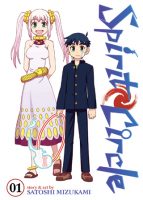 Spirit Circle, Volume 1 by Satoshi Mizukami. I rather enjoyed Lucifer and the Biscuit Hammer, currently the only other manga series by Mizukami to be licensed in English. I would have been interested in Spirit Circle for that reason alone, but I’ve also been hearing great (and well-deserved) things about the manga beyond that. Like it’s predecessor in English (which is actually briefly referenced in passing), Spirit Circle is a manga that’s a little strange and quirky but that also has a great deal of heart and soul. Fuuta Okeya has the ability to see ghosts. That by itself would generally be enough to form the basic premise of a series, but thanks to a new transfer student, Fuuta must now also confront his past lives. Though meeting Fuuta for the first time in this life, Kouko Ishigami is very familiar with his previous incarnations. Historically, their encounters haven’t always gone so well, though. In the first volume of Spirit Circle, Fuuta is made to relive two of his pasts to the point of his deaths and parts of a third life are revealed as well. So far, I’m loving Spirit Circle. Fuuta and Kouko’s past lives are filled with heartbreaks and joys, echoes of which are apparent in the teenagers’ current existences. Taken separately, the stories are interesting, but together they’re marvelous. I’m very curious to see where Mizukami takes the series next.
Spirit Circle, Volume 1 by Satoshi Mizukami. I rather enjoyed Lucifer and the Biscuit Hammer, currently the only other manga series by Mizukami to be licensed in English. I would have been interested in Spirit Circle for that reason alone, but I’ve also been hearing great (and well-deserved) things about the manga beyond that. Like it’s predecessor in English (which is actually briefly referenced in passing), Spirit Circle is a manga that’s a little strange and quirky but that also has a great deal of heart and soul. Fuuta Okeya has the ability to see ghosts. That by itself would generally be enough to form the basic premise of a series, but thanks to a new transfer student, Fuuta must now also confront his past lives. Though meeting Fuuta for the first time in this life, Kouko Ishigami is very familiar with his previous incarnations. Historically, their encounters haven’t always gone so well, though. In the first volume of Spirit Circle, Fuuta is made to relive two of his pasts to the point of his deaths and parts of a third life are revealed as well. So far, I’m loving Spirit Circle. Fuuta and Kouko’s past lives are filled with heartbreaks and joys, echoes of which are apparent in the teenagers’ current existences. Taken separately, the stories are interesting, but together they’re marvelous. I’m very curious to see where Mizukami takes the series next.
 Sweet Bean Paste by Durian Sukegawa. The 2015 film adaptation of Sukegawa’s novel An has been released internationally under several different titles–Sweet Red Bean Paste, An, and Sweet Bean–and now the original work has been translated into English with yet another title variation, Sweet Bean Paste. I’ve not seen Naomi Kawase’s film, but it seems to have been generally well-received. As for Sukegawa’s original novel, it makes for a fairly quick and light read despite some of the story’s more tragic undercurrents and philosophical musings. Sentaro is a man with a criminal past, out of prison but still working off his debt by making and selling dorayaki in a confectionery shop owned by the widow of his boss. He’s not particularly invested in the job, but that begins to change when an elderly woman named Tokue, her hands disfigured from a childhood illness, convinces him to let her join him at the shop. Bringing a unique perspective on life along with a recipe for sweet bean paste more delicious than any other Sentaro has tasted, Tokue has a huge influence upon the younger man as their unexpected friendship blossoms. Although much about Tokue’s past is unfortunate and she continues to deal with the stigma associated with leprosy, she has still found a way to live on in the face of prejudice and discontent. Sentaro has much to learn from Tokue, even if the lessons are bittersweet.
Sweet Bean Paste by Durian Sukegawa. The 2015 film adaptation of Sukegawa’s novel An has been released internationally under several different titles–Sweet Red Bean Paste, An, and Sweet Bean–and now the original work has been translated into English with yet another title variation, Sweet Bean Paste. I’ve not seen Naomi Kawase’s film, but it seems to have been generally well-received. As for Sukegawa’s original novel, it makes for a fairly quick and light read despite some of the story’s more tragic undercurrents and philosophical musings. Sentaro is a man with a criminal past, out of prison but still working off his debt by making and selling dorayaki in a confectionery shop owned by the widow of his boss. He’s not particularly invested in the job, but that begins to change when an elderly woman named Tokue, her hands disfigured from a childhood illness, convinces him to let her join him at the shop. Bringing a unique perspective on life along with a recipe for sweet bean paste more delicious than any other Sentaro has tasted, Tokue has a huge influence upon the younger man as their unexpected friendship blossoms. Although much about Tokue’s past is unfortunate and she continues to deal with the stigma associated with leprosy, she has still found a way to live on in the face of prejudice and discontent. Sentaro has much to learn from Tokue, even if the lessons are bittersweet.

